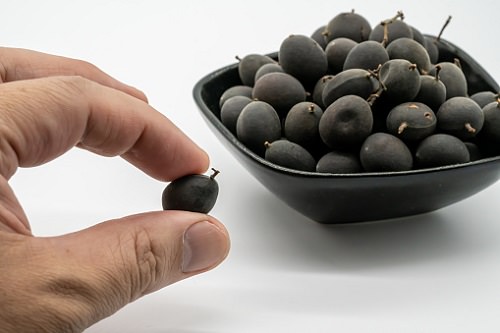These black tamarind benefits will surprise you as they are not just plentiful but potent as well. Keep reading to know more.
Black tamarind, also popular as black velvet tamarind, is the tropical Dialium guineense tree. It is native to West Africa but is now widespread in Sri Lanka and India as well. Various parts of the plant have found uses in traditional medicine. The non-medical value of the fruit, flowers, and seeds in cooking and the utility of the wood and bark in construction, furniture, and artwork is notable.
The fruit is enclosed in a brittle velvety shell that houses 1 or 2 round, brown seeds and the dry brown pulp, which has a characteristic sweet and sour taste. Often eaten raw or sun-dried, the pulp is popularly soaked in water and consumed as a tart beverage. It is a popular ingredient in making jam/jelly. It brings a potent sour flavor in cooking.
Nutritional Value
The tamarind fruit comprises:
- 37% shell/husk
- 35% pulp
- 28% seed
- Carbohydrates are the predominant macronutrient with a high concentration of glucose and fructose.
- Black tamarind is a rich source of micronutrients like copper, iron, manganese, zinc, phosphorus, potassium, calcium, magnesium, and essential amino acids.
- The amount of ascorbic acid Vitamin C in black tamarind is remarkable.
Black Tamarind Benefits
If you consume black tamarind regularly, the nutrients in black tamarind fruit will evoke the following health benefits.
1. Heart Health
The antioxidants and potassium in black tamarind help reduce the risk of cardiovascular disease and improve heart health.
2. For Anemia
It aids in repairing blood vessels and improves iron absorption, thereby helps in fighting iron deficiency. Lack of iron in the body gives rise to anemia.
3. Immunity Booster
Black tamarind fruit strengthens the immune system by increasing the mobility of white blood cells and promotes the production of immunoglobulins. The manganese and calcium in the pulp accelerate blood coagulation to aid wound healing.
4. Helpful in Hemorrhoids
The fruit of black tamarind may help treat hemorrhoids by reducing inflammation and shrinking abscesses.
5. For Constipation
Fibers present in the fruit prevent constipation, improve bowel movements and promote colon health by eliminating toxins. The fibers also aid in lowering cholesterol levels.
6. For Pregnant Women
The fruit has an anti-abortifacient that prevents miscarriage. Therefore many people encourage its consumption as it helps in avoiding pregnancy loss.
7. Eye Health
Black tamarind extract contains a compound similar to mucin, which makes it useful as an ingredient in eye drops to treat dry eyes.
8. Aids Ailments
The vitamin C content in tamarind pulp is effective in fighting scurvy and it has potent antimicrobial property too. The polyphenols in the pulp protect the liver from hepatotoxins. The leaves of the plant are rich in potassium that balances electrolyte levels in the body to combat muscle fatigue and also tackle hypertension. You can chew the leaves to increase the secretion of gastric mucus and also prevent ulcers.
9. Diuretic Advantages
Leaf extracts of the tree serve as an excellent diuretic, it increases urine production by the kidney. Simultaneously, it lowers sodium levels and eliminates excess fluids. This also reduces the pressure on the heart.
10. Anti-Parasitic
A decoction of the leaves shall inhibit the growth of Plasmodium falciparum. Plasmodium falciparum is the parasite responsible for malaria.
11. Effects on Blood Sugar Levels
It lowers blood glucose levels and improves insulin sensitivity, thereby alleviating Type 2 diabetes symptoms.
12. Wound Healing
Leaf extracts, when applied directly, encourage wound healing and protect the injury from germs and moisture contamination.
13. For Oral Health
The stem is used as a chewing stick for brushing the teeth. The stem contains saponin that clears plaque, fights bacteria, prevents tooth decay, and soothes toothache.
14. Other Benefits
The pulp of the tamarind fruit helps in improving lactation by increasing breast milk secretion. Besides, the antioxidants neutralize harmful free radicals that are a multifaceted threat to overall health.
15. Traditional Medicine Uses
Ethnomedicine practices across Africa acknowledge the anti-diarrhoeal and analgesic (pain-killing) properties of the bark. In traditional medicine, the decoction from the bark is used to reduce bronchial inflammation and also relieve cough.
Precautions:
- If the use is unregulated, it may also lead to dangerously low blood sugar levels.
- If you’re using it for the first time, watch out for allergy symptoms. These symptoms include rashes, itching, inflammation, nausea, dizziness, vomiting, or shortness of breath.





